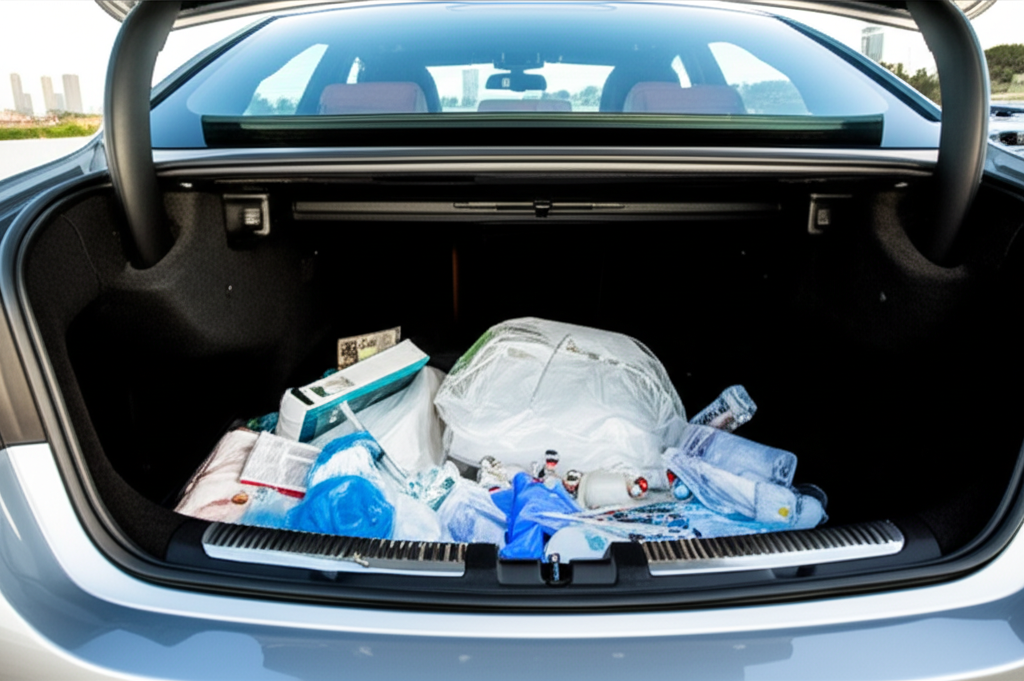BMW Biomedical Waste Management: 7 Facts

BMW Biomedical Waste Management: 7 Critical Facts You Need to Know are essential for safe handling and disposal, ensuring compliance with stringent U.S. regulations to protect public health and the environment.
Key Takeaways
- Understand the unique challenges of BMW waste.
- Learn about regulatory frameworks governing BMW disposal.
- Identify proper segregation and labeling methods.
- Discover best practices for collection and transportation.
- Explore treatment and disposal technologies.
- Recognize the importance of training and documentation.
- Stay updated on emerging trends in BMW waste management.
As a car owner in the USA, you’re accustomed to a world of automotive innovation, luxury, and cutting-edge technology. From the sleek designs of BMW to the robust performance of American muscle cars, our roads are a testament to automotive excellence. However, alongside this impressive automotive landscape comes a unique set of responsibilities, especially when dealing with complex waste streams. You might be wondering about “BMW” in a context different from your favorite car brand. This article isn’t about car maintenance, but about a critical aspect of healthcare and public safety: Biomedical Waste Management. It can seem confusing, but we’re here to break down the essential facts about BMW, or Biomedical Waste, so you feel informed and confident. Let’s dive into what you need to know about BMW biomedical waste management.
What Is Biomedical Waste (BMW)?
Biomedical Waste (BMW), sometimes referred to as regulated medical waste or infectious waste, encompasses a broad category of waste materials generated by healthcare facilities, laboratories, and even some household sources. These materials pose a potential risk of infection or injury because they may contain infectious agents, be sharp, or be otherwise hazardous. Understanding what constitutes BMW is the first crucial step in its proper management. In the United States, the classification and handling of BMW are governed by specific federal and state regulations to prevent the spread of disease and protect waste handlers.
7 Critical Facts About BMW Biomedical Waste Management

Managing biomedical waste requires a meticulous approach, governed by strict guidelines across the United States. These facts are designed to provide you with a clear understanding of this vital process, ensuring safety and compliance.
Fact 1: Definition and Categories of BMW
Biomedical waste is not a single entity; it’s a classification that includes several distinct categories, each requiring specific handling and disposal protocols. Recognizing these categories is fundamental to correct segregation and management. In the U.S., these categories are generally defined by federal guidelines and further refined by state and local health departments. For instance, the Occupational Safety and Health Administration (OSHA) provides guidelines for bloodborne pathogens, which are highly relevant to BMW management.
Common Categories of Biomedical Waste:
- Infectious Waste: This includes cultures and stocks of infectious agents, waste from biological research, and contaminated lab waste. It can pose direct risks of infection to anyone exposed.
- Pathological Waste: This category involves human or animal tissues, organs, body parts, and body fluids that are removed during surgery, autopsy, or other medical procedures.
- Sharps Waste: Any discarded item that can penetrate the skin, such as needles, scalpels, broken glass (from labs or diagnostic procedures), and disposable razors. These are a significant concern due to their potential for injury and disease transmission.
- Pharmaceutical Waste: Expired or unused medications, vaccines, and other pharmaceutical products that are no longer needed. This can include controlled substances, requiring additional security and disposal protocols.
- Chemotherapeutic Waste: Waste generated from the preparation or administration of cytotoxic drugs used in cancer treatment. This waste is often considered hazardous and requires special treatment.
- Radioactive Waste: Waste materials that contain radioactive substances. While not always classified strictly as medical waste, it is often managed by healthcare facilities and has its own set of stringent regulations.
The accurate identification and segregation of these waste streams are paramount. Improperly categorized waste can lead to cross-contamination, increased disposal costs, and potential legal penalties. For example, a used syringe, classified as sharps waste, must never be mixed with general laboratory waste.
Fact 2: Regulatory Landscape in the USA
The management of BMW in the United States is a multi-layered regulatory affair involving federal agencies, state health departments, and often local authorities. This complex framework aims to protect both public health and the environment. Understanding these regulations is not just about compliance; it’s about responsible stewardship.
Key Regulatory Bodies and Their Roles:
- Environmental Protection Agency (EPA): The EPA sets standards for the disposal of hazardous waste, and some components of BMW may fall under their purview, particularly when they exhibit hazardous characteristics. They also oversee regulations related to infectious waste. You can find more on their hazardous waste regulations at EPA’s Hazardous Waste Website.
- Occupational Safety and Health Administration (OSHA): OSHA’s primary concern is the safety of workers who handle BMW. Their Bloodborne Pathogens Standard (29 CFR 1910.1030) is critical, mandating procedures for handling, storage, and disposal to minimize occupational exposure risks.
- State Departments of Health (DOH): Each state has its own specific regulations for BMW management, often more stringent than federal guidelines. These can include requirements for permits, specific treatment methods, and disposal site licenses.
- Department of Transportation (DOT): When BMW is transported, especially across state lines, DOT regulations apply to ensure safe packaging, labeling, and transport methods to prevent spills or exposure during transit.
Navigating these regulations can seem daunting. However, many healthcare facilities work with specialized BMW disposal companies that are experts in U.S. federal and state compliance. These companies ensure that all waste is handled according to the latest legal requirements.
Fact 3: Segregation and Proper Labeling are Crucial
The principle of “segregation at the source” is the cornerstone of effective BMW management. This means identifying and separating BMW from general waste at the point of generation. Proper segregation prevents contamination of non-hazardous waste and ensures that BMW is treated and disposed of appropriately, often at a higher cost. Labeling is equally vital; it clearly identifies the contents of a container and its associated hazards.
Best Practices for Segregation and Labeling:
- Color-Coding: Many facilities use color-coded bags and containers. Red is commonly used for infectious waste, yellow for pathological and chemotherapy waste, and black for trace chemotherapy waste. Sharps are placed in rigid, puncture-resistant containers, often red or yellow.
- Dedicated Containers: Use designated, leak-proof containers for different types of BMW. These containers should be strong enough to prevent leaks and tears.
- Clear Labeling: All BMW containers must be clearly labeled with the universal biohazard symbol and other required information, such as the origin of the waste and the category. Labels should be legible and durable.
- No Overfilling: Containers should not be filled beyond their capacity. For bags, they should typically be filled to about two-thirds full before being securely closed.
A common mistake is to treat all medical waste as general trash. For example, a bandage soaked with blood from a patient with a known infection is BMW and requires containment, while a clean bandage from a minor scrape might not. This distinction is critical.
Fact 4: Safe Collection and Transportation Protocols
Once segregated and labeled, BMW must be collected and transported safely. This process is fraught with potential risks if not managed correctly. The goal is to move the waste from its point of generation to a treatment facility with minimal risk of exposure or environmental release.
Key Steps in Collection and Transportation:
- Inner and Outer Packaging: Infectious waste is often placed in red biohazard bags, which are then placed inside secondary leak-proof containers. This double-bagging system provides an extra layer of protection.
- Puncture-Resistant Sharps Containers: Needles and other sharps must be placed in FDA-cleared, puncture-resistant, leak-proof sharps containers. These containers are typically red or yellow and must be replaced when they are three-quarters full.
- Secure Storage Areas: BMW awaiting collection should be stored in designated, secure areas that are inaccessible to the public and protected from pests and extreme weather.
- Licensed Transporters: Only licensed and trained professionals should transport BMW. These transporters adhere to strict DOT and EPA regulations regarding vehicle requirements, manifest systems, and emergency procedures.
- Manifest System: A manifest is a tracking document that accompanies the waste from the point of generation to the final disposal site. It provides a chain of custody and ensures accountability, as mandated by many state regulations.
You’ve likely seen specialized trucks with biohazard markings making pickups from hospitals or clinics. These vehicles are designed to safely contain waste, and the drivers are trained in handling hazardous materials and emergency response.
Fact 5: Treatment and Disposal Technologies
The final destination for BMW is crucial for public health and environmental safety. Before disposal, BMW is typically treated to render it non-infectious. Various technologies are employed, depending on the type of waste and regulatory requirements.
Common Treatment Methods:
Here’s a look at some widely used methods for treating BMW:
| Treatment Method | Description | Best For | Considerations |
|---|---|---|---|
| Autoclaving (Steam Sterilization) | High-pressure steam is used to kill microorganisms. It is a widely used, effective, and relatively cost-efficient method. | Infectious waste, pathological waste, some sharps. | Cannot be used for bulk chemotherapy waste or large anatomical parts. Treated waste can often be disposed of in landfills. |
| Incineration | High-temperature burning of waste. This method destroys pathogens and reduces waste volume significantly. | Pathological waste, chemotherapy waste, pharmaceutical waste, sharps. | Can be expensive, requires sophisticated air pollution control systems, and produces ash that may require hazardous waste disposal. |
| Chemical Disinfection | Using chemical agents (like chlorine or ozone) to kill microorganisms. Typically used for liquid waste or smaller volumes. | Liquid infectious waste, lab waste. | Effectiveness can vary, and residual chemicals may pose disposal challenges. |
| Microwave Treatment | Uses microwave energy to heat and sterilize waste. | Similar to autoclaving, can be effective for various waste streams. | Requires specialized equipment; effectiveness depends on waste composition. |
| Irradiation | Uses gamma radiation or electron beams to sterilize waste. | Used for a wide range of BMW. | High initial capital cost and safety concerns related to radiation. |
After treatment, the residual waste is usually rendered non-infectious and can be sent to a sanitary landfill. However, some treated waste, like incinerator ash, may still require special disposal depending on its composition.
Fact 6: The Importance of Training and Documentation
Human error is a significant risk factor in BMW management. Comprehensive training for all personnel who handle BMW, from initial generation to final disposal, is non-negotiable. Equally important is meticulous record-keeping and documentation.
Essential Training Components:
- Understanding BMW Categories: Personnel must be able to correctly identify and segregate different types of BMW.
- Safe Handling Procedures: Training on proper use of personal protective equipment (PPE), safe sharps handling, and spill response is vital.
- Regulatory Compliance: Awareness of federal, state, and local regulations governing BMW is crucial.
- Emergency Procedures: Knowing what to do in case of a spill, leak, or accidental exposure is paramount.
Key Documentation Requirements:
- Training Records: Proof that all relevant personnel have received adequate training.
- Waste Manifests: Records tracking waste from generator to disposal.
- Permits and Licenses: Documentation showing compliance with facility and transporter permits.
- Disposal Certificates: Records from the treatment and disposal facility confirming proper handling.
Many institutions use specialized training modules and software to manage these aspects, ensuring compliance and minimizing risks. For example, a nurse needs to know how to correctly dispose of a syringe filled with a patient’s blood, while a laboratory technician needs to understand how to handle cultures.
Fact 7: Sustainability and Emerging Trends in BMW Management
The field of BMW management is constantly evolving, with a growing focus on sustainability and technological advancements. The traditional methods of disposal, like incineration, are being re-evaluated for their environmental impact, leading to the exploration of greener alternatives.
Key Trends to Watch:
- Waste Reduction Strategies: Implementing policies and technologies to minimize BMW generation at the source.
- Advanced Sterilization Technologies: Development of more efficient and environmentally friendly treatment methods, such as plasma gasification or advanced chemical treatments.
- Recycling of Non-Contaminated Materials: Efforts to identify and recycle materials used in healthcare settings that are not contaminated with biohazards.
- Circular Economy Principles: Exploring how BMW management can align with broader circular economy goals, reducing waste sent to landfills and maximizing resource utilization.
- Enhanced Monitoring and Tracking: Utilizing digital technologies for better real-time tracking and auditing of BMW from generation to disposal.
As environmental consciousness grows, so does the pressure on healthcare and waste management sectors to adopt more sustainable practices. This includes not only how waste is treated but also how it’s generated and its lifecycle considered.
Pro Tips for BMW Waste Management
Always perform regular audits of your BMW segregation practices to identify and correct any deviations. Ensure your PPE is readily available and in good condition for all staff handling waste.
Frequently Asked Questions (FAQ)

What is the difference between general medical waste and biomedical waste?
General medical waste can include items like packaging, office supplies, and non-contaminated materials from a healthcare setting. Biomedical waste (BMW), on the other hand, is waste that is potentially infectious, pathological, or poses a sharps hazard. Regulations focus on the proper segregation and disposal of BMW due to its higher risk.
Can anyone dispose of biomedical waste?
No, only trained personnel following strict protocols and licensed waste disposal companies are authorized to handle and transport biomedical waste. Improper disposal by untrained individuals can lead to severe health risks and legal penalties.
How is sharps waste managed differently from other BMW?
Sharps waste, such as needles and scalpels, must be placed in puncture-resistant, leak-proof containers immediately after use. These containers are specifically designed to prevent accidental punctures, and they are collected and treated separately from other types of BMW.
What happens if BMW is disposed of incorrectly?
Incorrect disposal of BMW can lead to the spread of infectious diseases, injuries to waste handlers and the public, environmental contamination, and significant legal liabilities for the generating facility, including hefty fines and operational shutdowns.
Are there specific regulations for household biomedical waste?
Yes, while most BMW is generated by healthcare facilities, households can also generate BMW (e.g., from home-administered injections for diabetes). Regulations vary by state and locality, but generally, sharps should be placed in sturdy plastic containers (like detergent bottles) and disposed of through designated community programs, not in regular trash or recycling bins.
What are the costs associated with BMW management?
BMW management is significantly more expensive than general waste disposal. Costs include specialized containers, regulated collection services, advanced treatment technologies, regulatory compliance, and insurance. The cost is justified by the critical need to protect public health and the environment.
How can businesses ensure they are compliant with BMW regulations?
Businesses should partner with reputable, licensed biomedical waste disposal companies. They should also implement comprehensive internal training programs for staff, maintain detailed records, and conduct regular self-audits to ensure adherence to all relevant federal, state, and local regulations.
Navigating the world of BMW biomedical waste management is a critical task for any entity generating such waste. From understanding the nuanced definitions of waste categories to adhering to the stringent regulatory frameworks, each step is designed with public health and environmental protection in mind. The dedicated segregation, careful collection, safe transportation, and advanced treatment of BMW are not just procedural requirements; they are essential safeguards. As the USA continues to lead in automotive innovation and technological advancement, it also upholds its commitment to safety and responsibility in all sectors, including the vital area of biomedical waste handling. By staying informed and implementing best practices, you contribute to a healthier and safer community for everyone.




